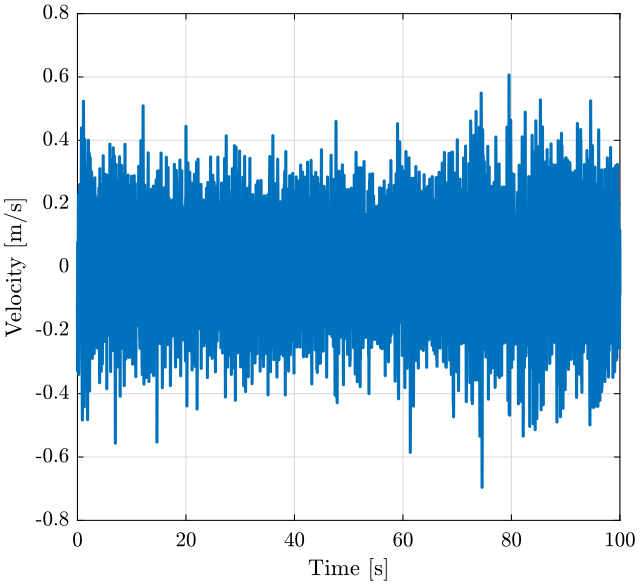11 KiB
Compute Spectral Densities of signals with Matlab
- Sensitivity of the instrumentation
- Convert the time domain from volts to velocity
- Power Spectral Density and Amplitude Spectral Density
- Modification of a signal's Power Spectral Density when going through an LTI system
- From PSD of the velocity to the PSD of the displacement
- Bibliography
This document presents the mathematics as well as the matlab scripts to do the spectral analysis of a measured signal.
Typically this signal is coming from an inertial sensor, a force sensor or any other sensor.
We here take the example of a signal coming from a Geophone measurement the vertical velocity of the floor at the ESRF.
Sensitivity of the instrumentation
Convert the time domain from volts to velocity
Let's say, we know that the sensitivity of the geophone used is \[ G_g(s) = G_0 \frac{\frac{s}{2\pi f_0}}{1 + \frac{s}{2\pi f_0}} \quad \left[\frac{V}{m/s}\right] \]
G0 = 88; % Sensitivity [V/(m/s)]
f0 = 2; % Cut-off frequency [Hz]
Gg = G0*(s/2/pi/f0)/(1+s/2/pi/f0);And the gain of the amplifier is 1000: $G_m(s) = 1000$.
Gm = 1000;If ${G_m(s)}^{-1} {G_g(s)}^{-1}$ is proper, we can simulate this dynamical system to go from the voltage to the velocity units (figure fig:voltage_to_velocity).
data = load('mat/data_028.mat', 'data'); data = data.data;
t = data(:, 3); % [s]
x = data(:, 1)-mean(data(:, 1)); % The offset if removed (coming from the voltage amplifier) [v]
dt = t(2)-t(1); Fs = 1/dt;We simulate this system with matlab:
v = lsim(inv(Gg*Gm), v, t);And we plot the obtained velocity
figure;
plot(t, v);
xlabel("Time [s]"); ylabel("Velocity [m/s]"); <<plt-matlab>>Power Spectral Density and Amplitude Spectral Density
We now have the velocity in the time domain: \[ v(t)\ [m/s] \]
To compute the Power Spectral Density (PSD): \[ S_v(f)\ \left[\frac{(m/s)^2}{Hz}\right] \]
To compute that with matlab, we use the pwelch function.
We first have to defined a window:
win = hanning(ceil(10*Fs)); % 10s window [Sv, f] = pwelch(v, win, [], [], Fs); figure;
loglog(f, Sv);
xlabel('Frequency [Hz]');
ylabel('Power Spectral Density $\left[\frac{(m/s)^2}{Hz}\right]$') <<plt-matlab>>The Amplitude Spectral Density (ASD) is the square root of the Power Spectral Density:
figure;
loglog(f, sqrt(Sv));
xlabel('Frequency [Hz]');
ylabel('Amplitude Spectral Density $\left[\frac{m/s}{\sqrt{Hz}}\right]$') <<plt-matlab>>Modification of a signal's Power Spectral Density when going through an LTI system
From PSD of the velocity to the PSD of the displacement
The displacement is the integral of the velocity.
We then have that
\begin{equation} S_{xx}(\omega) = \left|\frac{1}{j \omega}\right|^2 S_{vv}(\omega) \end{equation}Using a frequency variable in Hz:
\begin{equation} S_{xx}(f) = \left| \frac{1}{j 2\pi f} \right|^2 S_{vv}(f) \end{equation}For the Amplitude Spectral Density:
\begin{equation} \Gamma_{xx}(f) = \frac{1}{2\pi f} \Gamma_{vv}(f) \end{equation}Now if we want to obtain the Power Spectral Density of the Position or Acceleration: For each frequency: \[ \left| \frac{d sin(2 \pi f t)}{dt} \right| = | 2 \pi f | \times | \cos(2\pi f t) | \]
\[ \left| \int_0^t sin(2 \pi f \tau) d\tau \right| = \left| \frac{1}{2 \pi f} \right| \times | \cos(2\pi f t) | \]
\[ ASD_x(f) = \frac{1}{2\pi f} ASD_v(f) \ \left[\frac{m}{\sqrt{Hz}}\right] \]
\[ ASD_a(f) = 2\pi f ASD_v(f) \ \left[\frac{m/s^2}{\sqrt{Hz}}\right] \] And we have \[ PSD_x(f) = {ASD_x(f)}^2 = \frac{1}{(2 \pi f)^2} {ASD_v(f)}^2 = \frac{1}{(2 \pi f)^2} PSD_v(f) \]
Note here that we always have \[ PSD_x \left(f = \frac{1}{2\pi}\right) = PSD_v \left(f = \frac{1}{2\pi}\right) = PSD_a \left(f = \frac{1}{2\pi}\right), \quad \frac{1}{2\pi} \approx 0.16 [Hz] \]
If we want to compute the Cumulative Power Spectrum: \[ CPS_v(f) = \int_0^f PSD_v(\nu) d\nu \quad [(m/s)^2] \]
We can also want to integrate from high frequency to low frequency: \[ CPS_v(f) = \int_f^\infty PSD_v(\nu) d\nu \quad [(m/s)^2] \]
The Cumulative Amplitude Spectrum is then the square root of the Cumulative Power Spectrum: \[ CAS_v(f) = \sqrt{CPS_v(f)} = \sqrt{\int_f^\infty PSD_v(\nu) d\nu} \quad [m/s] \]
Then, we can obtain the Root Mean Square value of the velocity: \[ v_{\text{rms}} = CAS_v(0) \quad [m/s \ \text{rms}] \]
Bibliography ignore
bibliographystyle:unsrt bibliography:ref.bib




